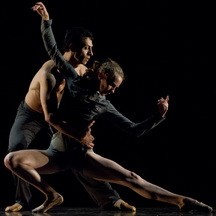
Cloud Gate Dance Theater’s dream of life
This past weekend Cal Performances presented the Taiwan-based dance group Cloud Gate Dance Theater in their latest production, Rice.
It might be difficult, at first, to imagine why the topic of rice could be the subject of something as abstract and emotionally charged as dance is and strives to be. But this beautifully realized work reaches into the darkest and most politically fraught of today’s human fears. For Rice is a paean to and celebration of one small region of the world’s solution to our current ecological crisis.
Based on the story of a village in the East Rift Valley of Taiwan that saved its crop and the basis of its economy by changing its farming practices from chemical to organic, Rice presents a broader representation of the plant life that is both the glory and the sustenance of planet.
It does so by tracing the cycle of rice – through image, sound and the human body that is nurtured by plants.
The performance opens with a narrow band of projected images, barely as high as a man, of water and stones. A dancer walks across the stage, holding a long pole of rattan, which he subtly shakes, causing its ends to vibrate. He is joined by a woman who, like a worker in the field, uses her steps and movements to create a percussive tattoo, shifting the vibration of the staff into sound. The natural sounds that accompany the opening of the dance are replaced by a man singing. This is traditional Hakka music, the songs of an ancient Chinese people whose origins are under debate and were the first agriculturists on the island of Taiwan.
Gradually the videos and the dancers change, as does the music, which moves from voice to taiko drumming, and from ancient Chinese song to Romantic European song, and back. The songs maintain the connection to the natural world, even the aria from Bellini’s Norma is a prayer to the “Pure Goddess, whose silver covers/ These sacred ancient plants”. The shivering quality of the coloratura finds its analog in the images of wind moving the grass blades of the growing rice plants in waves of brilliant green.
Just as there is always a kinetic link between sounds and images in Rice, there is also a visual and kinetic link between the films/sounds and the dancers’ movements. It is easy to imagine that Lin Hwai-min, the choreographer and director of the troupe, looked long and hard at the films of videographer Chang Hao-jan, condensing what he saw into his choice of music and resolving those sounds into gesture and movement. So finely attuned is each element to the other two aspects of the performance.
Chang’s imagery is the most kinetically subtle element in Rice. The films, which were taken during a two-year period in the village of Chihshang, are comprised of long sequences that dwell on the moment and then quietly dissolve into another lingering sequence.
Two sequences are especially striking in the choreography. The duet called “Pollen” and the ensemble piece “Fire”. In the first, Huan Pei-hua and Tsai Ming-yuan, in flesh colored leotards, writhe over under and around each other, in a duet filled with and urgent intimacy. The projections of green vegetable matter narrow down to a human-sized rectangle that is reflected by a green patch of light on the stage floor. It’s hard to tell where hip ends and arm begins, stomach presses and knee bumps. It is strikingly sexual but lacking in the coyness that characterizes so many dance duets. It is a reenactment of the rite of spring, without the feverish dissonance. It is brilliant in its understanding portrayal of the deep drives of creation.
“Fire” uses movement reminiscent of Shaolin stick fighting, unlike the majority of the piece’s dance vocabulary, which is modern dance at its heart. The smack of the sticks on the stage imitate the snap and crackle of burning grass, and the martial arts steps of the dancing give the sequence vigor and energy.
The entire performance was absorbing and transformed the work into a portrayal that was both political and deeply aesthetic. An extraordinarily difficult blend to achieve but one that is totally in sync with the goals of Cal Performances RADICAL initiative, which focuses on “artistic exploration” in “the context of global ecological concerns.” A series of workshops and symposia are also a part of the program, which runs from January 22-31.
The next series of events features David Robertson and the St. Louis Symphony in Messiaen’s Des canyons aux étoiles, with a multimedia essay by photographer Deborah O’Grady. Visit www.calperformances.org for information.
– Jaime Robles
Photo: Cal Performances presents Cloud Gate Theatre of Taiwan’s Hsin-fang Lin, Chien-hung Yu, and Tsung-hsuan Lee in Rice at Zellerbach Hall. Photo by Chen-hsiang Liu.
